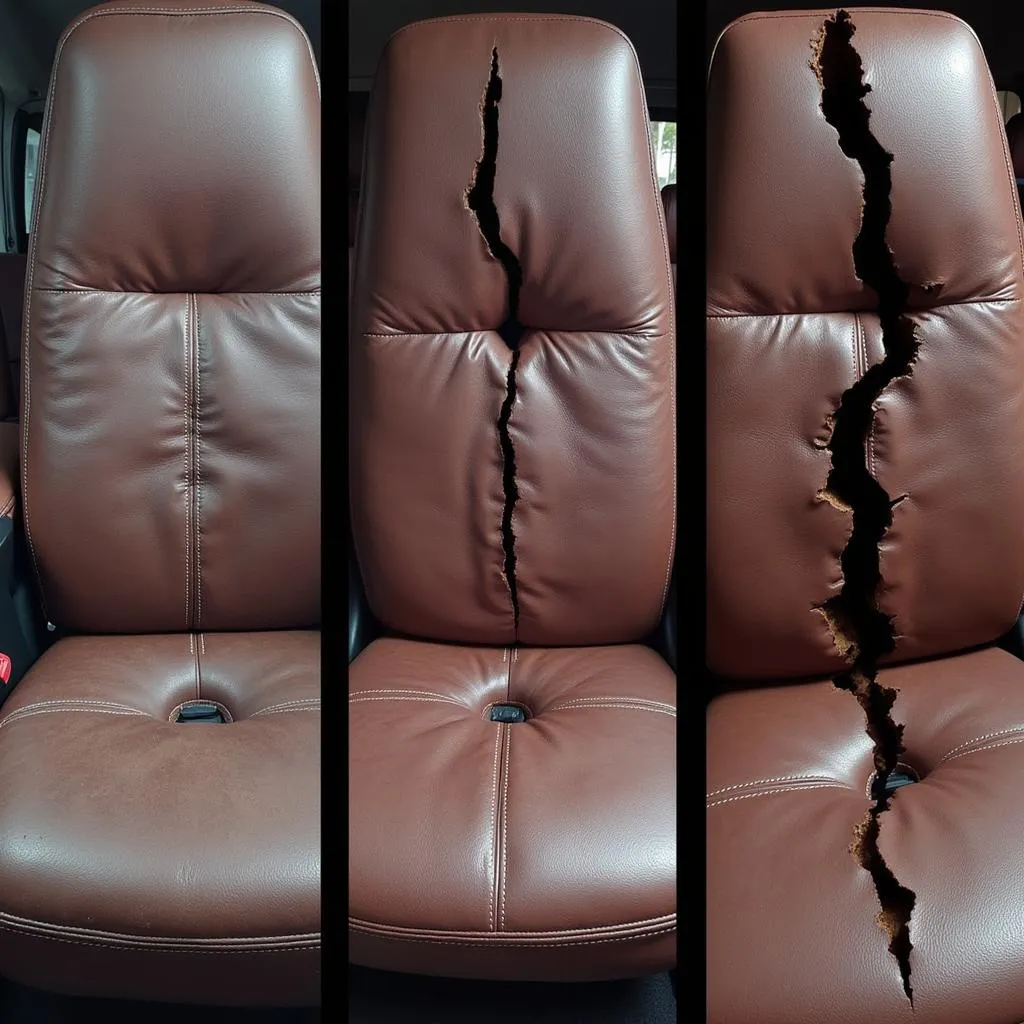A tear in your leather car seat can be a real eyesore. But before you start panicking about the cost of reupholstering your entire car, take a deep breath! Repairing a tear in leather car seat is often easier than you think, especially if you’re dealing with a minor tear. This comprehensive guide will walk you through the steps to tackle this common problem and get your car interior looking its best again.
Assessing the Damage: How Bad Is It?
Before diving into the repair, it’s important to assess the severity of the tear in your leather car seat. This will help you determine the best repair method and what materials you’ll need.
- Small Tears and Cracks: These are generally superficial and affect only the top layer of the leather. They can often be repaired with a leather filler or adhesive.
- Medium Tears: These tears penetrate deeper into the leather and might require patching with a leather repair kit.
- Large Tears and Rips: For extensive damage or tears on seams, professional upholstery repair might be the best course of action.
DIY Leather Car Seat Repair: Materials You’ll Need
For small to medium tears, you can often repair the damage yourself using a DIY approach. Here are the essential materials you’ll need:
- Leather Cleaner: Use a dedicated leather cleaner to remove dirt, grime, and any existing leather conditioner from the affected area.
- Leather Repair Kit: These kits typically include a color-matched filler paste, a backing fabric, an application tool, and instructions.
- Rubbing Alcohol: This is used to clean the area around the tear and ensure proper adhesion of the repair materials.
- Clean Cloth: Microfiber cloths are ideal for cleaning and buffing the leather.
- Scissors: For cutting the backing fabric or any loose leather fibers.
Step-by-Step Guide: Repairing a Tear in Leather Car Seat
Follow these steps to effectively repair a tear in your leather car seat:
-
Clean the Area: Begin by thoroughly cleaning the torn area and surrounding leather with a dedicated leather cleaner. Make sure to remove all dirt, dust, and debris for optimal repair results.
-
Prepare the Tear: If there are any loose leather fibers around the tear, carefully trim them away using sharp scissors. Be careful not to make the tear larger.
-
Apply the Backing Fabric (If Necessary): For larger tears, use the backing fabric from your repair kit to create a supportive base. Cut the fabric slightly larger than the tear and insert it under the torn edges using the application tool.
-
Fill the Tear: Apply the leather filler paste to the tear, pushing it into the edges and smoothing it out with the application tool. Build up the filler in thin layers, allowing each layer to dry before applying the next.
-
Dry and Sand: Allow the filler to dry completely according to the manufacturer’s instructions. Once dry, use fine-grit sandpaper to gently smooth out any rough edges or excess filler.
-
Apply Leather Dye (If Necessary): If the color of the filler doesn’t perfectly match your leather, use a leather dye that matches your car’s interior to blend the repair. Apply the dye in thin layers, allowing each layer to dry completely.
-
Condition the Leather: Once the repair is complete and the dye is dry, apply a high-quality leather conditioner to the entire seat. This will help moisturize the leather and prevent future cracking.
When to Call a Professional
While DIY repair kits can be effective for minor to moderate tears, some situations call for professional expertise.
Consider professional upholstery repair if:
- The tear is located on a seam: Seam repairs require specialized sewing techniques and are best left to the professionals.
- The tear is larger than 2 inches: Large tears often require more complex patching and might be difficult to repair seamlessly without professional equipment.
- The tear involves heated or cooled seats: Working with heated or cooled seats requires additional care and knowledge of the seat’s wiring to avoid damage.
Preventing Future Tears
Prevention is always better than cure! Here are some tips to prevent future tears in your leather car seats:
- Regular Cleaning and Conditioning: Keep your leather seats clean and conditioned to prevent drying, cracking, and becoming more susceptible to tears.
- Avoid Sharp Objects: Be mindful of sharp objects like keys, pens, and tools that can easily puncture or scratch leather.
- Use Seat Covers: Consider using seat covers, especially if you frequently transport pets, children, or cargo that could potentially damage the seats.
- Address Small Issues Promptly: Don’t ignore small cracks or scratches. Addressing them early can prevent them from developing into larger tears.
Conclusion
Repairing a tear in your leather car seat doesn’t have to be a daunting task. By following these steps and using the right materials, you can often restore your car’s interior to its former glory. Remember to assess the damage carefully and consider professional repair for larger or more complex tears. With a little effort and care, you can keep your leather car seats looking their best for years to come!
FAQs about Leather Car Seat Repair
1. Can I use super glue to fix a tear in my leather car seat?
While super glue might seem like a quick fix, it’s not recommended for leather car seat repairs. Super glue dries rigidly and can crack or damage the leather further. Opt for a flexible leather adhesive or a dedicated leather repair kit instead.
2. How long does it take for a leather seat repair to dry?
Drying times vary depending on the type of filler and leather dye used. Refer to the manufacturer’s instructions for specific drying times. In general, allow at least 24 hours for the repair to dry completely before using the seat.
3. How much does it cost to have a leather car seat professionally repaired?
The cost of professional repair varies depending on the extent of the damage, the type of leather, and the location of the repair shop. On average, expect to pay between $100 to $500 for professional leather car seat repair.
4. Can I prevent my leather car seats from fading in the sun?
UV rays from the sun can fade leather over time. Park your car in the shade whenever possible, use a sunshade, and regularly condition your leather seats with a UV protectant to minimize sun damage.
5. How often should I condition my leather car seats?
It’s recommended to condition your leather car seats every 3-6 months, or more frequently if you live in a harsh climate.
Still unsure?
If you have any other questions about repairing a tear in your leather car seat or need further assistance, don’t hesitate to reach out to our team of car care experts. We are here to help! You can contact us through WhatsApp: +1(641)206-8880 or email us at [email protected]. We have a 24/7 customer support team ready to assist you.



